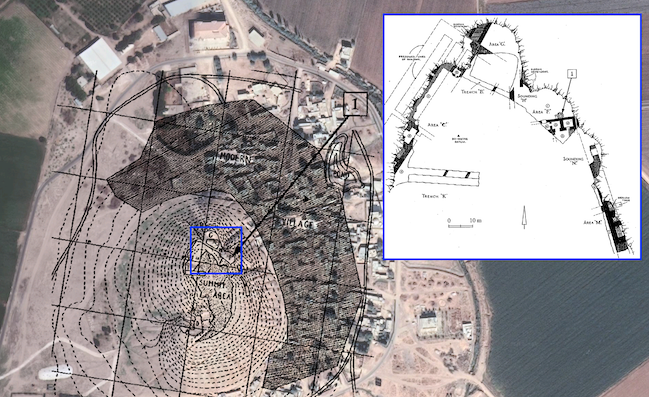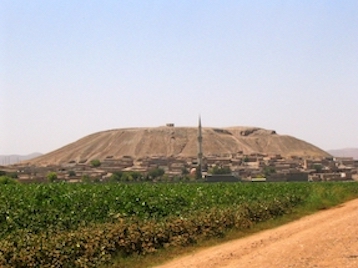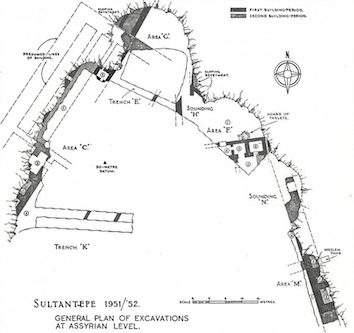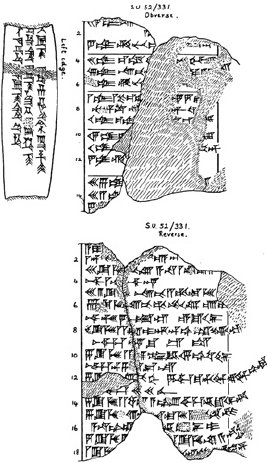You are seeing an unstyled version of this site. If this is because you are using an older web browser, we recommend that you upgrade to a modern, standards-compliant browser such as FireFox [http://www.getfirefox.com/], which is available free of charge for Windows, Mac and Linux.
Neo-Assyrian Archival Texts from Huzirina

The settlement mound of Sultantepe is situated in the Şanlıurfa Province in southeastern Turkey, at a distance of some 15 km from the modern city of Şanlıurfa (Roman Edessa). Sultantepe lies on a tributary of the Balikh river and is thus directly connected with the nearby Assyrian city of Harran, in whose province the site was situated.

View of the settlement mound of Sultantepe, with the modern village of Sultantepe Köyü surrounding it. Photo by Klaus-Peter Simon [https://commons.wikimedia.org/w/index.php?curid=6940386] (2004). This image is licensed under the Creative Commons Attribution 3.0 Unported license [https://creativecommons.org/licenses/by/3.0/deed.en].
Sultantepe is a small but rather steeply-sloped mound whose lower town is covered by the modern village of Sultantepe Köyü. By the mid-twentieth century, the forces of erosion, which target the mound's slopes mercilessly, had exposed large column bases made from basalt, and these could be stylistically assigned to the Iron Age with confidence. It was therefore reasonable to assume that the corresponding archaeological levels would date to the Neo-Assyrian Period. However, these layers are only easily accessible at the edges of the mound as they are otherwise covered by seven meters' worth of later settlement layers.
Nevertheless, despite these difficult conditions and after a promising brief survey in 1950, the Anglo-Turkish Joint Excavations project took up work at Sultantepe in the years 1951–52 under the direction of Nuri Gökçe of the Hittite Museum in Ankara (now called the Museum of Anatolian Civilizations) and Seton Lloyd of the British Institute of Archaeology in Ankara (BIAA [https://biaa.ac.uk/research/item/name/sultantepe-survey]). The archaeologists mostly targeted the Neo-Assyrian layers and achieved significant discoveries, as they exposed the monumental entrance to the ancient citadel and parts of various other buildings. Their most famous find is the so-called Tablet Hoard, a large collection of about 400 Neo-Assyrian clay tablets that was found in secondary position outside a building on the northeastern side of the settlement mound on June 5th 1951.

Plan of the Neo-Assyrian settlement levels at Sultantepe, as exposed during the 1951–52 excavations. Reproduced from Lloyd and Gökçe, Anatolian Studies [https://www.jstor.org/stable/3642385?seq=1] 3 (1953): 30 fig. 2.
In addition, a much smaller archive of four legal documents was excavated in a building that was partially exposed on the northwestern side of the mound. These texts were published in a 1957 article by Jacob J. Finkelstein and are dated to the years 684–674 BC. As in the case of Burmarina [/atae/burmarina] and Sam'al [/atae/samal], one is tempted to seek a connection between the end of that small archive and the local consequences of the widespread conspiracy [/saao/knpp/essentials/esarhaddon/index.html] against king Esarhaddon [/rinap/rinap4/] (681–669 BC) in the late 670s BC. After all, that insurrection movement took its departure from the city of Harran, located a mere 23 km southeast of Sultantepe, where a prophecy communicated through a local woman provided the ideological foundation for the rebellion against Esarhaddon. The woman had fallen into ecstasy and uttered a portentous divine message: "This is the word of the god Nusku: Kingship belongs to Sasî. I shall destroy the name and the seed of Sennacherib!" (SAA 16 59 [/atae/P313533]). This prophecy proclaimed Sennacherib's [rinap/rinap3/] son Esarhaddon and his heirs as impostors, unworthy to rule over Assyria, and was the cause of much turmoil and bloodshed as the rebellion quickly spread and the king asserted his power with great violence. As a Babylonian chronicle text puts it in the sole entry for the year 670 BC: "In Assyria, the king killed many of his great ones with the sword."

A hand-drawn facsimile of SU 1952, 331 (STT 048 [/atae/huzirina/P338366]). Reproduced from Gurney and Finkelstein, The Sultantepe Tablets 1 [https://www.jstor.org/stable/10.18866/j.ctt1pc5h0w], London, 1957.
The much larger archive of the "Tablet Hoard" constitutes the tablet collection of a family of local priests and the texts were written by various members of the clan between 718 BC and the final years of the Assyrian Empire; the priest Qurdi-Nergal and his son Mušallim-Baba are the best attested members of the family. Nearby Harran was the last refuge of the remnants of the imperial apparatus and the royal court after Nineveh had been lost in 612 BC. That the archive was found in a secondary position but still grouped together could suggest that someone — perhaps a member of the family or possibly a looter — tried to move the precious tablet collection when the settlement became engulfed in the warfare that brought about Harran's conquest by Babylonian troops in 608 BC.
The Oxford Assyriologist Oliver Gurney was assigned primary responsibility for the publication of the "Tablet Hoard [https://biaa.ac.uk/research/item/name/study-of-the-sultantepe-tablets). It is to his enormous credit that he almost immediately started to make]." It is to his enormous credit that he almost immediately started to make the texts available in a series of articles published in the BIAA's academic journal Anatolian Studies. Two volumes with the tablets' definitive editions appeared in 1957 (by Oliver Gurney and Jacob J. Finkelstein) and 1964 (by Oliver Gurney and Peter Hulin). A number of texts from this archive can be accessed through our Archival Texts of the Assyrian Empire corpus pages, either because they have been edited in various volumes of the State Archives of Assyria series (including the manuscripts of the eponym lists) or because they are indeed "archival" in nature, such as the administrative lists STT 048 [/atae/huzirina/P338366] and STT 405 [/atae/huzirina/P338719]. The "Tablet Hoard" of Qurdi-Nergal and his family was also one of the case studies of a research project led by Eleanor Robson from 2007–12 entitled "The Geography of Knowledge in Assyria and Babylonia: A Diachronic Analysis of Four Scholarly Libraries" (GKAB [/cams/gkab/]), and the project website provides much information on the tablet collection, as well as editions of many of its literary, religious, medical, astronomical and divinatory texts (explore the GKAB corpus [/cams/gkab/corpus/]; sort by "Place/Time/Genre" for easy access of the relevant material).
The settlement mound of Sultantepe is identified with the Assyrian city of Huzirina. This place name is mentioned prominently in a number of tablets from both archives found at the site, including the personnel list STT 406+ [/atae/huzirina/P338720] from Qurdi-Nergal's tablet collection, which is introduced by the heading "[The servants of] the goddess Ištar of Huzirina, [that the king] has given [to] the god Nusku", and the slave sale document SU 1951, 036 [/atae/huzirina/P338308] from the small legal archive, in which one of the witnesses is identified as "[... of] Huzirina."
Since 1952, no further archaeological work has been conducted in Sultantepe. The tablets and other finds are kept in the Museum of Anatolian Civilizations in Ankara.
Click here [/atae/huzirina/pager] to browse the Huzirina corpus.
The aim of the Huzirina sub-project of ATAE is to make the published Neo-Assyrian archival texts from Sultantepe available online for free in a fully searchable and richly annotated (lemmatized) format, as well as to widely disseminate, facilitate, and promote the active use of these important cuneiform sources in academia and beyond. ATAE/Huzirina presently includes Neo-Assyrian sources edited and discussed in the following publications:
- P. Clancier, "Qurdi-Nergal's house in Huzirina [/cams/gkab/contexts/huzirina/index.html]," The Geography of Knowledge in Assyria and Babylonia: A Diachronic Analysis of Four Scholarly Libraries [/cams/gkab/], 2019;
- K. Deller, "Neuassyrisches aus Sultantepe," [https://www.jstor.org/stable/43073862] Orientalia 34 (1965): 457-477;
- J.J. Finkelstein, "Assyrian Contracts from Sultantepe," [https://www.jstor.org/stable/3642350] Anatolian Studies 7 (1957): 137-145;
- O.R. Gurney and J.J. Finkelstein, The Sultantepe Tablets 1, London, 1957 (View book [https://www.jstor.org/stable/10.18866/j.ctt1pc5h0w] on JSTOR [requires subscription]);
- O.R. Gurney and P. Hulin, The Sultantepe Tablets 2, London 1964 (View book [https://www.jstor.org/stable/10.18866/j.ctt1pc5h4z] on JSTOR [requires subscription]);
- L. Kataja and R. Whiting, Grants, Decrees and Gifts of the Neo-Assyrian Period (State Archives of Assyria 12 [/saao/saa12/]), Helsinki, 1995;
- A. Livingstone, Assyrian Court Poetry and Literary Miscellanea (State Archives of Assyria 3 [/saao/saa03/]), Helsinki 1989;
- A. R. Millard, The Eponyms of the Assyrian Empire 910-612 B.C. (State Archives of Assyria Studies 2 [/saao/saas2/]), Helsinki 1994;
- S. Parpola, Royal Rituals and Cultic Texts (State Archives of Assyria 20 [/saao/saa20/]), Winona Lake, IN, 2017; and
- Greta Van Buylaere, "STT 048 [/cams/gkab/P338366]" and "STT 2, 405 [/cams/gkab/P338719]," The Geography of Knowledge in Assyria and Babylonia: A Diachronic Analysis of Four Scholarly Libraries [/cams/gkab/].
ATAE is a key component of the Archival Texts of the Middle East in Antiquity (ATMEA) sub-project of the LMU-Munich-based Munich Open-access Cuneiform Corpus Initiative [https://www.en.ag.geschichte.uni-muenchen.de/research/mocci/index.html] (MOCCI; directed by Karen Radner and Jamie Novotny). Funding for the ATAE corpus project has been provided by LMU Munich and the Alexander von Humboldt Foundation (through the establishment of the Alexander von Humboldt Chair for Ancient History of the Near and Middle East).
For further details, see the "About the project" [/atae/abouttheproject/index.html] page.

Home Page banner credit
Satellite image of the ruins of Huzirina (modern Sultantepe) overlaid with a general plan of the city, showing the location of the archive of Qurdi-Nergal and his son Mušallim-Baba (Pedersén, Archives and Libraries in the Ancient Near East 1500-300 B.C. pp. 179–180 Plans 87–88). Image prepared by Jamie Novotny.
Karen Radner
Karen Radner, 'Neo-Assyrian Archival Texts from Huzirina', Neo-Assyrian Archival Texts from Huzirina, The ATAE/Huzirina Project, a sub-project of MOCCI, 2023 [http://oracc.org/huzirina/]